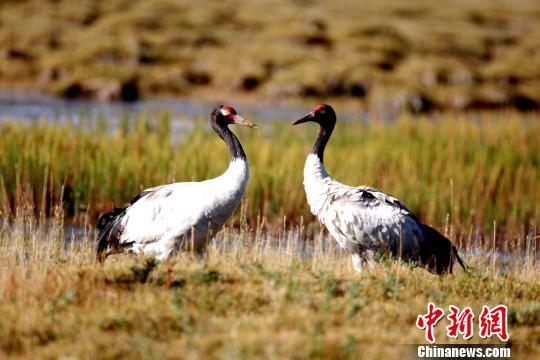Black-necked cranes steady in number at source of Yangtze River

The black-necked crane [Photo/China News Service]
"In the past two years, the number of black-necked cranes has surpassed 180 and stayed steady in their population inside the Rongpo National Nature Conservation District and the Gyatang Meadows at the source of the Yangtze River in Yushu Prefecture of Qinghai Province," said Zhaoxiang, director of the Three Rivers Source Program of the Shanshui Natural Protection Center, a non-governmental organization on natural protection in China, during an interview.
Black-necked crane is a species which could indicate ecological changes on plateau. The black-necked cranes primarily inhabit in the plateau meadows, reed swamp, and marshland at an altitude from 2,500 to 5,000 meters, and they're the only crane species which live and cultivate on the Qinghai-Tibet Plateau. In 1989, the black-necked cranes were listed as China's first class protected wildlife species, and also added to the CITES index in 1997.
Around May of every year, black-necked cranes incubate on the Qinghai-Tibet Plateau; by the end of Oct, the cranes and their young migrate to warmer area in southern Tibet and Yunnan Province. According to conservative estimate of present species' distribution, there're more than 1,500 black-necked cranes inhabiting at the source of the Yangtze River, the Yellow River, and the Lancang River.
Wang Enguang, Vice Chief of the Department of Forestry in Qinghai Province, explained that black-necked cranes and other water fowls are selective of their living environment, so the fact that they are here indicates the improvement of the local ecology.
Editor: Tommy Tan.
Tibet Stories

The Tibetan prince of music: Derge Yer
Derge Yer is a Tibetan singer from Guinan County of Hainan Tibetan Autonomous Prefecture in ...
Latest News
- S.Korea, DPRK agree to conduct joint railway inspection
- Angry over cutbacks, Trump threatens to end subsidies to GM
- Trump backs use of 'very safe' tear gas on crowd of migrants
- UN chief concerned over incident involving Ukrainian, Russian vessels
- Ukrainian martial law may cause escalation of tensions in Donbass: Kremlin





